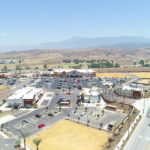By Rebecca Meiser | ICSC.com
At a time when market forces are causing developers to rethink projects and put the brakes on shopping center developments, Lewis Retail Centers has taken a more optimistic, long-term view of retail real estate. In July, it began construction on a 62,000-square-foot Safeway grocery store that will become the third anchor of the Damonte Ranch Town Center in Reno, Nevada. The company plans to open two centers in 2022: a 93,000-square-foot, grocery-anchored neighborhood center in Ontario, California, and a 163,000-square-foot center in Chino, California, with live/work units. Both are part of multi-use, planned communities that Lewis Centers’ parent, The Lewis Group of Cos., is developing. “Our basic assumption is that life is going to go on, the economy is going to go on,” said Lewis Group executive vice president of marketing Randall Lewis, who spoke with SCT contributing editor Rebecca Meiser.

What makes you so confident in shopping center development during this time?
I’d probably use the phrase “cautious optimism.” We are not plungers, and we are well aware of the challenges in the industry. We like the business a lot, but we are also pretty opportunistic. We are trying to seek out those centers in our master-planned communities where we know there are going to be X thousand of houses over the next few years or where, because of our market knowledge, we understand the growing areas and where we feel highly confident that there is going to be a lot of population growth. The other part of it is that a number of our centers are brought to us by tenants who say they have a hole in their market coverage. Can we try to find something in a certain area? If we have a tenant coming to us saying, ‘We want to go somewhere,’ that’s a big help.
What’s your shopping center development strategy?
Identify growing residential populations that have no retail or are under-retailed so that we can deliver exactly what the community and surrounding cities need. We analyze projections for new homes in the area. We also use location analytics to best understand the future trade area. By combining traditional demographics with newer location-analytic data, we are able to develop a good understanding of what a viable project will look like and how to develop a list of potential tenants.
How do Lewis Group’s master-planned communities affect Lewis Retail Centers’ development?
At any given time, we have at least a dozen master-planned communities. Some we’re entitling. Some are closed. Some are more open. Our master projects typically encompass 100 to 500 acres. We buy a piece of land, we get it entitled and then we do the planning, thinking through: Where’s thefor-sale housing? Where’s the apartments? Where should the shopping center be? Not every one of our master plans has a shopping center component, but when they do, we try to place it. We can actually grow sites for good shopping centers as we’re planning a large-scale development. We try to think, ‘Where is a Main and Main in that new development?’ Then, it’s just a matter of waiting until we get the right number of households. [Lewis Group’s residential expertise also] gives us an advantage on properties that aren’t in our own master-planned communities. We have a pretty good handle on where growth is coming, and we also have a good handle on who is going to be living in those new communities. So knowing the homebuilder network like we do, we can know what’s coming, when it’s coming and are they going to be high-end or lower-end [housing] and whether it will be singles or families.
In the spring, you opened California’s 105,000-square-foot Marketplace at Calimesa, anchored by a Stater Bros. Markets grocery store. How was the reaction? How did the pandemic affect the opening?
It always takes longer to build things because of COVID and sometimes it’s harder to get some of the materials, so we had to make some adjustments there. Some of the construction took a little longer than we expected. The good news on Calimesa was that it came to an area that was very, very undeserved and there was no real competition for about a four-mile radius. The response from the community has been very strong. We’ve gotten very positive feedback both from the local community and also from the elected officials.
Tenants there include Starbucks, Cold Stone Creamery and Supercuts. What is your approach to tenancy? Has it changed since the pandemic? We’ve always had a bias to the stronger tenants, the tenants where we have confidence in their credit. We build most of centers with the hope to hold them a long, long time. If we have two tenants and one might pay a tiny bit more but we don’t know if they’re going to survive, we are going to take the tenant we think is the more solid long-term tenant.



